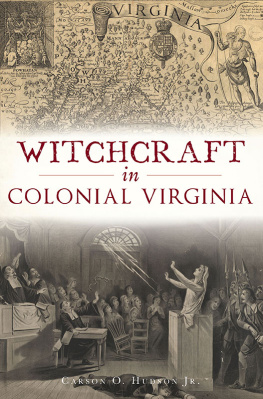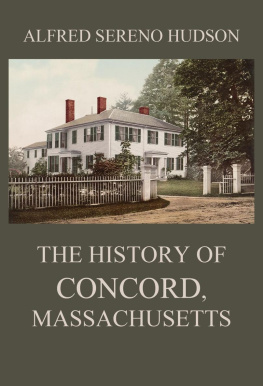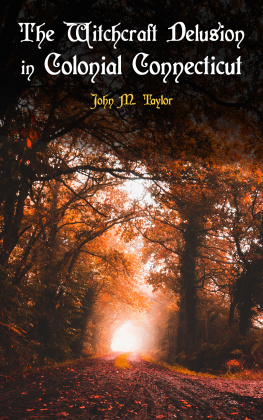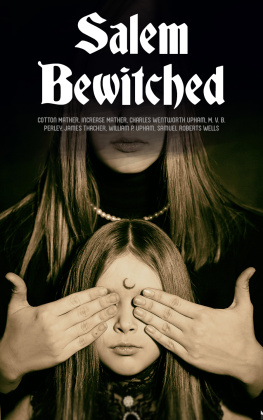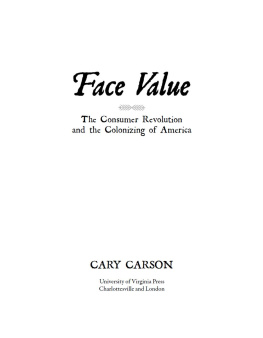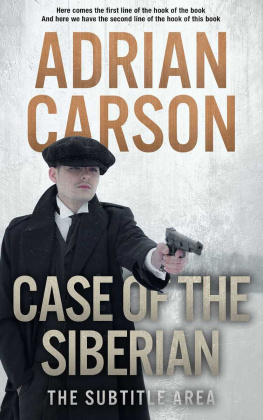Carson O. Hudson Jr. - Witchcraft in Colonial Virginia
Here you can read online Carson O. Hudson Jr. - Witchcraft in Colonial Virginia full text of the book (entire story) in english for free. Download pdf and epub, get meaning, cover and reviews about this ebook. year: 2019, publisher: Arcadia Publishing Inc., genre: Religion. Description of the work, (preface) as well as reviews are available. Best literature library LitArk.com created for fans of good reading and offers a wide selection of genres:
Romance novel
Science fiction
Adventure
Detective
Science
History
Home and family
Prose
Art
Politics
Computer
Non-fiction
Religion
Business
Children
Humor
Choose a favorite category and find really read worthwhile books. Enjoy immersion in the world of imagination, feel the emotions of the characters or learn something new for yourself, make an fascinating discovery.
- Book:Witchcraft in Colonial Virginia
- Author:
- Publisher:Arcadia Publishing Inc.
- Genre:
- Year:2019
- Rating:5 / 5
- Favourites:Add to favourites
- Your mark:
- 100
- 1
- 2
- 3
- 4
- 5
Witchcraft in Colonial Virginia: summary, description and annotation
We offer to read an annotation, description, summary or preface (depends on what the author of the book "Witchcraft in Colonial Virginia" wrote himself). If you haven't found the necessary information about the book — write in the comments, we will try to find it.
Witchcraft in Colonial Virginia — read online for free the complete book (whole text) full work
Below is the text of the book, divided by pages. System saving the place of the last page read, allows you to conveniently read the book "Witchcraft in Colonial Virginia" online for free, without having to search again every time where you left off. Put a bookmark, and you can go to the page where you finished reading at any time.
Font size:
Interval:
Bookmark:

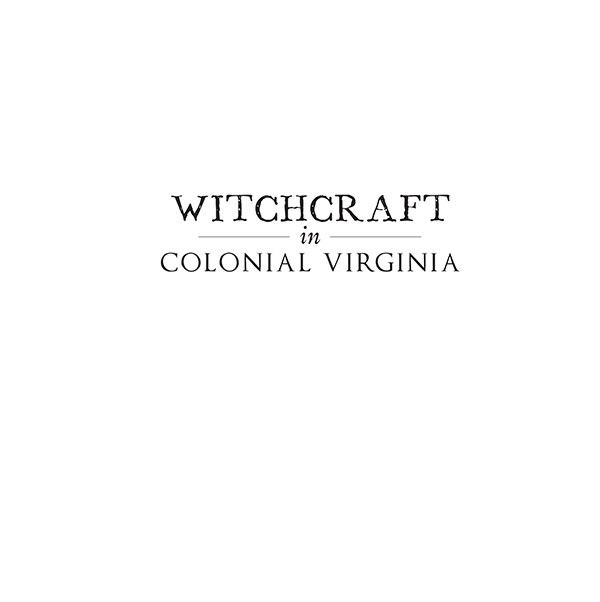

Published by The History Press
Charleston, SC
www.historypress.com
Copyright 2019 by Carson O. Hudson Jr.
All rights reserved
Front cover, top: John Smiths map of Virginia, 1626. Library of Congress. Bottom: Witch Number 1, by Joseph E. Baker, 1892. Library of Congress.
Title page: The devil appears. From Francesco Maria Guazzos Compendium Maleficarum, 1608.
First published 2019
e-book edition 2019
ISBN 978.1.43966.781.1
Library of Congress Control Number: 2019940047
print edition ISBN 978.1.46714.424.7
Notice: The information in this book is true and complete to the best of our knowledge. It is offered without guarantee on the part of the author or The History Press. The author and The History Press disclaim all liability in connection with the use of this book.
All rights reserved. No part of this book may be reproduced or transmitted in any form whatsoever without prior written permission from the publisher except in the case of brief quotations embodied in critical articles and reviews.
To the memory of Katherine Grady.
Hanged as a witch, off the coast of Virginia, 1654.
CONTENTS
PREFACE
Although I was and continue to be primarily a military historian, I began a study of witchcraft many years ago, specifically witchcraft cases in colonial Virginia. In those days, before the internet made resources much more convenient, I laboriously tracked down surviving colonial court documents, obscure books and treatises and every primary and secondary source I could locate. I was always looking for anything that would provide greater detail to the meager legal accounts that I found. I spoke with researchers, scholars, educators and legal historians seeking anyone who could provide me with information, opinions and explanations. All my research eventually resulted in a dramatic work, titled Cry Witch, for the Colonial Williamsburg Foundation.
I wasnt satisfied, however. Although actual period records were scarce, I had managed to acquire a lot of interesting background and related information. I also found that modern cultural beliefs about historic witchcraft were filled with myth, local legend and Hollywoods ideas of bad history. The result was I wrote a small book about the actual witchcraft beliefs and court cases that occurred in Virginia. Using a quote from Englands King James I, I titled my work These Detestable Slaves of the Devill. This, in turn, led me to begin lecturing on the subject, ensuring me speaking engagements every Halloween.
Over the last twenty years, Ive met with many people who have attended one of my lectures. Talking with them after a lecture or at a book signing, Ive found that for many, Hollywood still seems to be teaching historybut Ive also been able to find new contacts with additional historical sources and information.
Arcadia Publishing and The History Press have now given me the opportunity to revise, update and expand my original work. For that I am truly grateful. This new volume represents those efforts, and I hope it will be appreciated by those who wish to distinguish between reality and sensational myths and legends. And of course, Ill still have work at Halloween!
Carson Hudson Williamsburg, Virginia February 2019
ACKNOWLEDGEMENTS
In researching and writing about witchcraft in colonial Virginia, one feels much like the freeholders that comprised the juries of the county courts of the period. First, each instance of witchcraft must be discovered and investigated. Then, research needs to be conducted into the facts of each case. Finally, one must obtain opinions and make decisions regarding what may have actually happened in each case and what is legend or local Virginia folklore of the last three-hundred-plus years.
It would have been impossible to complete my investigations without the help of a number of friends and associates at the Colonial Williamsburg Foundation. They offered assistance, guidance and advice.
Especially valued were the opinions and suggestions of Jeremy Fried and Tom Hay, both fine historians of colonial Virginia law. Abigail Schumann shared her knowledge of seventeenth-century Virginia. Lou Powers and Kevin Kelly of Colonial Williamsburgs research department readily answered my often-strange questions. Gail Greve, Del Moore and Juleigh Clark, along with the rest of the staff of the Rockefeller Library, were of great assistance in locating obscure books and documents. A special thanks to Marianne Martin, who diligently searched for images I might use, and to Bob Ruegsegger, who graciously permitted me to use his photographs.
The helpful staff of the Virginia State Library guided me through an untold number of county records.
A fine historian and old friend, Anna Holloway, reviewed my notes and gave me valuable feedback, as did Anne Marie Millar, who provided constructive criticism.
I would like to thank Arcadia Publishing and especially Kate Jenkins, acquisitions editor of The History Press, who believed in my work. Her guidance through the world of publishing during the creation of this expanded edition of my original work was invaluable.
Finally, I must mention my long-suffering wife, Melissa. Being born in Kansas and a Wizard of Oz groupie, she easily tolerates a husband who spends way too much time reading and lecturing about witchcraft.
INTRODUCTION
On April 26, 1607, three small ships, the Susan Constant, the Godspeed and the Discovery, arrived off the coast of Virginia. They brought with them 104 men and boys who would construct a wooden palisade at a spot they called Jamestown, named for their king, James I. Thus, the first permanent English settlement in North America was established. The settlers who arrived on that spring day brought with them their thoughts of home and their cultural beliefs and values. Among their beliefs was the conviction that witches were alive and thriving in the world.
The seventeenth century was an age when witches and demons, alchemists and sorcerers, sea monsters and fanciful creatures were accepted by Englishmen, regardless of their social or intellectual station in life. A brief investigation of the literature and plays of their acquaintance confirms these beliefs. It is illustrated in such well-known pieces as Christopher Marlowes Doctor Faustus (1604) and William Shakespeares Midsummer Nights Dream (1595), Macbeth (1605) and The Tempest (1611). Similar plays characterizing contemporary beliefs were Thomas Middletons The Witch (1609) and The Witch of Edmonton (1621) by Thomas Dekker, John Ford and William Rowley.
Virginia, with its dark forests and strange native inhabitants, must have seemed quite frightening indeed. King James I himself had written that the devils handiwork was thought to be most common in such wilde partes of the world. It was there that the Devill findes greatest ignorance and barbaritie. For at least the next hundred years, Virginians would be on the lookout for the Satan and his followers.

Macbeths Three Witches
Next pageFont size:
Interval:
Bookmark:
Similar books «Witchcraft in Colonial Virginia»
Look at similar books to Witchcraft in Colonial Virginia. We have selected literature similar in name and meaning in the hope of providing readers with more options to find new, interesting, not yet read works.
Discussion, reviews of the book Witchcraft in Colonial Virginia and just readers' own opinions. Leave your comments, write what you think about the work, its meaning or the main characters. Specify what exactly you liked and what you didn't like, and why you think so.

